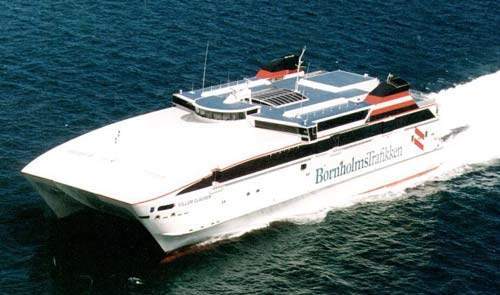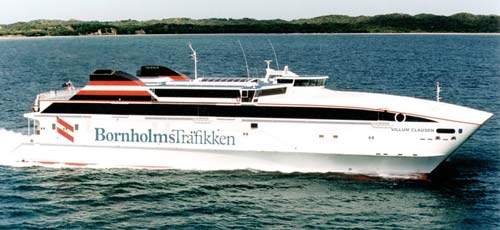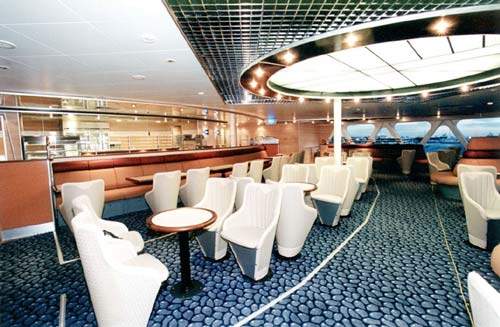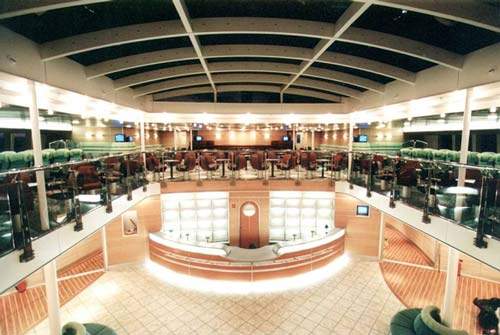Villum Clausen, constructed by Austal Ships, is the first gas turbine-powered vehicle ferry to be built in the southern hemisphere. Villum Clausen was delivered to lessors Borholmstrafikken in March 2000 and entered service between Rønne, on the island of Bornholm, and Ystad in April 2000.
During the delivery voyage, Villum Clausen established a new record for the longest distance travelled by a ship in 24 hours. On 16 and 17 February 2000, the vessel covered 1,063nm between Sumatra and Cochin, achieving a maximum speed of 47.7 knots and an average speed of 44.29 knots.
The vessel flies the Danish flag and is classed by Det Norske Veritas.
Design
Villum Clausen was designed with reference to the strict Danish environmental noise, wave wash and exhaust emission regulations. Gas turbines were selected primarily, due to the improved level of nitrous oxide emissions.
Danish legislation requires that fast ferries, when operating at service speed, generate a wave less than 0.35m in 3m of water. With the semi-swath hull form of the vessel, Austal Ships was able to demonstrate the design’s low-wash characteristics.
Facilities
Austal worked with Bornholmtraffiken’s interior designer, Steen Friss Design, on the passenger areas of the Villum Clausen. A contemporary Nordic feel was chosen. The curved bulkheads and walkways are designed to improve passenger flow. Throughout the accommodation areas, composite wall panels and furniture predominantly feature light alder and pear woodgrain finishes, with kiosks and ceiling insets fashioned with a variety of high-gloss effects.
The 2,000m² passenger and support services areas include a business class lounge, restaurant, bridge deck bar and lounge, children’s play area, reception and shopping area. There are 597 seats in the main deck lounges, 56 in a business class saloon and 384 on the upper passenger level. All 1,037 seats were custom-built by Beurteaux Australia, using drawings supplied by Steen Friis. Close attention was paid to ensure easy access for wheelchair users and information on-board is provided in Braille for visually impaired passengers.
Villum Clausen has nine main deck lanes and six mezzanine deck lanes, totalling 837 lane metres. The maximum vehicle payload of 380t would typically comprise 186 cars or a combination of up to 144 cars, ten coaches or trucks weighing up to 20t and 15 motorcycles. Clear height down the central three car lanes, or two commercial vehicle lanes, is 4.4m.
Propulsion
Villum Clausen is powered by two GE LM 2500 gas turbines, derated to 18,000kW at 3,600rpm, driving four Kamewa 112 SII waterjets via two Renk BS2 137 gearboxes. Service speed at 85% MCR is 41 knots with 485dwt on-board, maximum dwt is about 500t and fuel consumption at 85 per cent MCR is approximately 7.4t/h.
The Seastate ride control system on Villum Clausen comprises two T-foils forward and interceptors aft, each pair of which is powered by a dedicated electrical hydraulic package controlled from a digital network. The system can be used to reduce motion and trim the vessel.
Equipment in the wheelhouse includes a Kelvin Hughes package of radars, navigational equipment and Nucleus 2 Ecdis 5000 and Nucleus 6000A electronic chart navigation, C.Plath gyro, autopilot and magnetic compasses, Elac Echograph echo sounder and Leica DGPS and GMDSS Sea Area A1 radio installation. Helm chairs feature Kelvin Hughes Ergopod systems with trackerballs on the armrests for radar and chart display manipulation. The engineers station has colour LCD screens to monitor and control the systems aboard the vessel. Ride control data is also provided both to the engineer and on a helm console. As required by Danish regulations, the vessel is fitted with a voyage data recorder.
Villum Clausen is the first fast ferry to be fitted with an RFD Marine Evacuation System. Four MES stations with three self-contained liferafts are each capable of evacuating 275 people.











